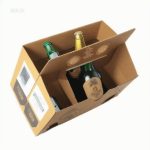In the complex world of healthcare, pharmaceutical packaging boxes serve as the unsung heroes that bridge the gap between laboratory precision and patient safety. These meticulously engineered containers are far more than simple cardboard housings—they represent the critical final layer of protection for medications that millions depend on daily. From temperature-sensitive biologics to life-saving emergency medications, pharmaceutical packaging boxes have evolved into sophisticated systems that preserve potency, prevent contamination, and ensure precise delivery to the end user.
The modern pharmaceutical packaging box is a marvel of engineering designed to address multiple challenges simultaneously. These containers incorporate specialized barriers against moisture, light, and oxygen—three elements that can degrade medication effectiveness. Advanced materials including child-resistant features, tamper-evident seals, and smart packaging technologies work in concert to create a comprehensive safety ecosystem. The integration of QR codes, NFC chips, and serialized identifiers has transformed ordinary boxes into interactive platforms that provide authentication, dosage reminders, and supply chain transparency.
Patient adherence represents one of the most significant challenges in healthcare, and pharmaceutical packaging has emerged as a powerful solution. Innovative box designs now incorporate clear dosing instructions, calendar-style blister packs, and color-coded systems that help patients manage complex medication regimens. For elderly patients or those managing multiple prescriptions, these intuitive packaging systems can mean the difference between successful treatment and dangerous medication errors. The psychological impact of well-designed packaging shouldn’t be underestimated—clear, professional presentation builds patient trust in both the medication and the prescribing healthcare provider.
Environmental considerations have pushed pharmaceutical packaging into a new era of sustainability. The industry is rapidly adopting recyclable materials, reducing package size and weight, and implementing circular economy principles without compromising product protection. Many manufacturers now use FSC-certified paperboard and water-based inks, while maintaining the stringent barrier properties required for pharmaceutical products. This environmental consciousness extends throughout the packaging lifecycle—from responsible sourcing to end-of-life recycling programs that align with global sustainability initiatives.
The global pandemic highlighted the critical role of pharmaceutical packaging in crisis situations. Vaccine distribution demanded unprecedented coordination between packaging engineers, logistics experts, and healthcare providers. Temperature-monitoring boxes with embedded sensors became essential tools in maintaining vaccine integrity across complex supply chains. This experience has accelerated innovation in smart packaging technologies, with future boxes likely to incorporate more sophisticated tracking capabilities and condition-monitoring systems that communicate directly with healthcare providers and patients.
Regulatory compliance forms the foundation of all pharmaceutical packaging development. Packaging manufacturers must navigate a complex web of international standards including FDA requirements, EU regulations, and country-specific guidelines. Each element—from the choice of materials to the printing of dosage information—must undergo rigorous validation processes. This regulatory framework ensures that every pharmaceutical packaging box meets consistent standards for safety, quality, and information accuracy, regardless of where the medication is manufactured or distributed.
Looking toward the future, pharmaceutical packaging boxes will continue to evolve as integrated healthcare platforms. We’re already seeing early developments in connected packaging that can monitor patient adherence, transmit data to healthcare providers, and even reorder medications automatically. The convergence of packaging design with digital health technologies promises to create more personalized medication experiences while maintaining the fundamental protective functions that make pharmaceutical packaging indispensable. As medications become more specialized and personalized, packaging solutions will need to adapt accordingly—potentially leading to smaller batch sizes and more customized packaging configurations.
The humble pharmaceutical packaging box has transformed from a simple container to a sophisticated healthcare interface. It protects delicate chemical compounds through challenging distribution networks, communicates essential information to diverse users, and increasingly serves as a connection point between patients and their healthcare ecosystem. In an industry where margins for error are nonexistent, these engineered solutions demonstrate how thoughtful design and advanced technology can work together to save lives and improve health outcomes worldwide.




Leave a Message